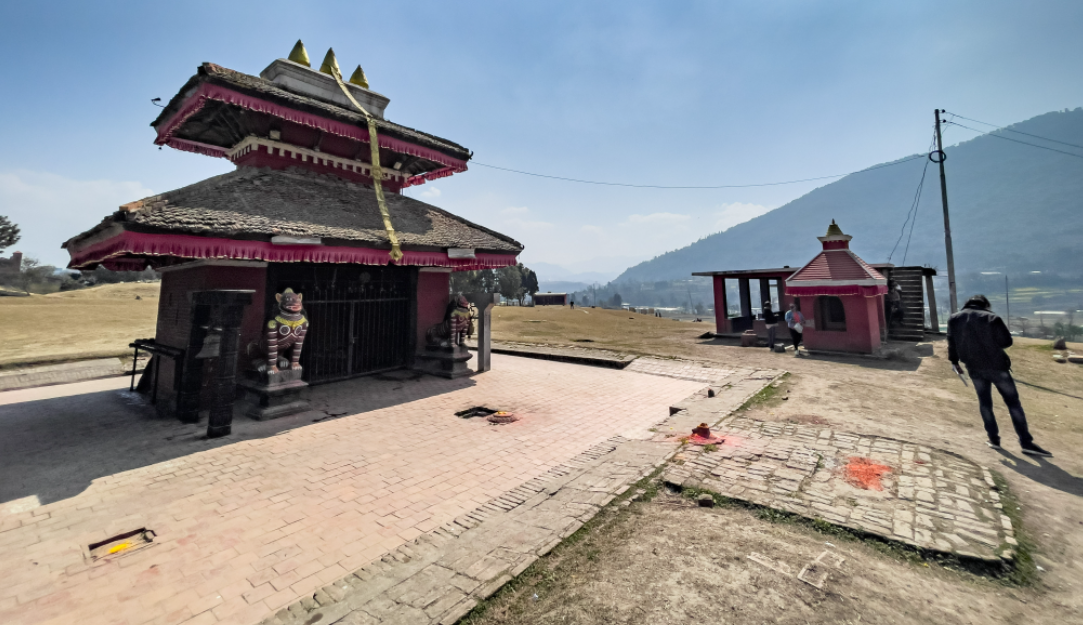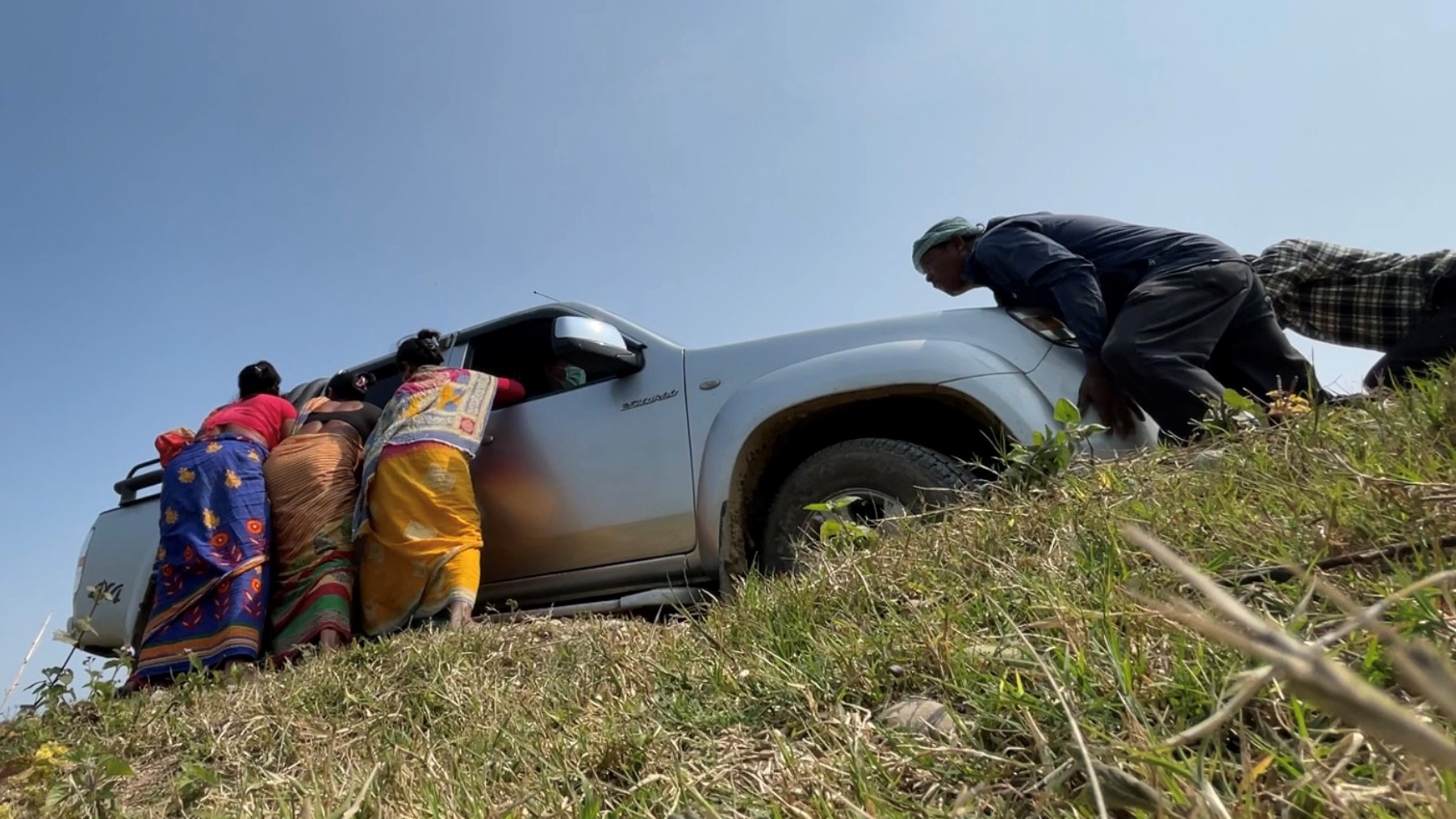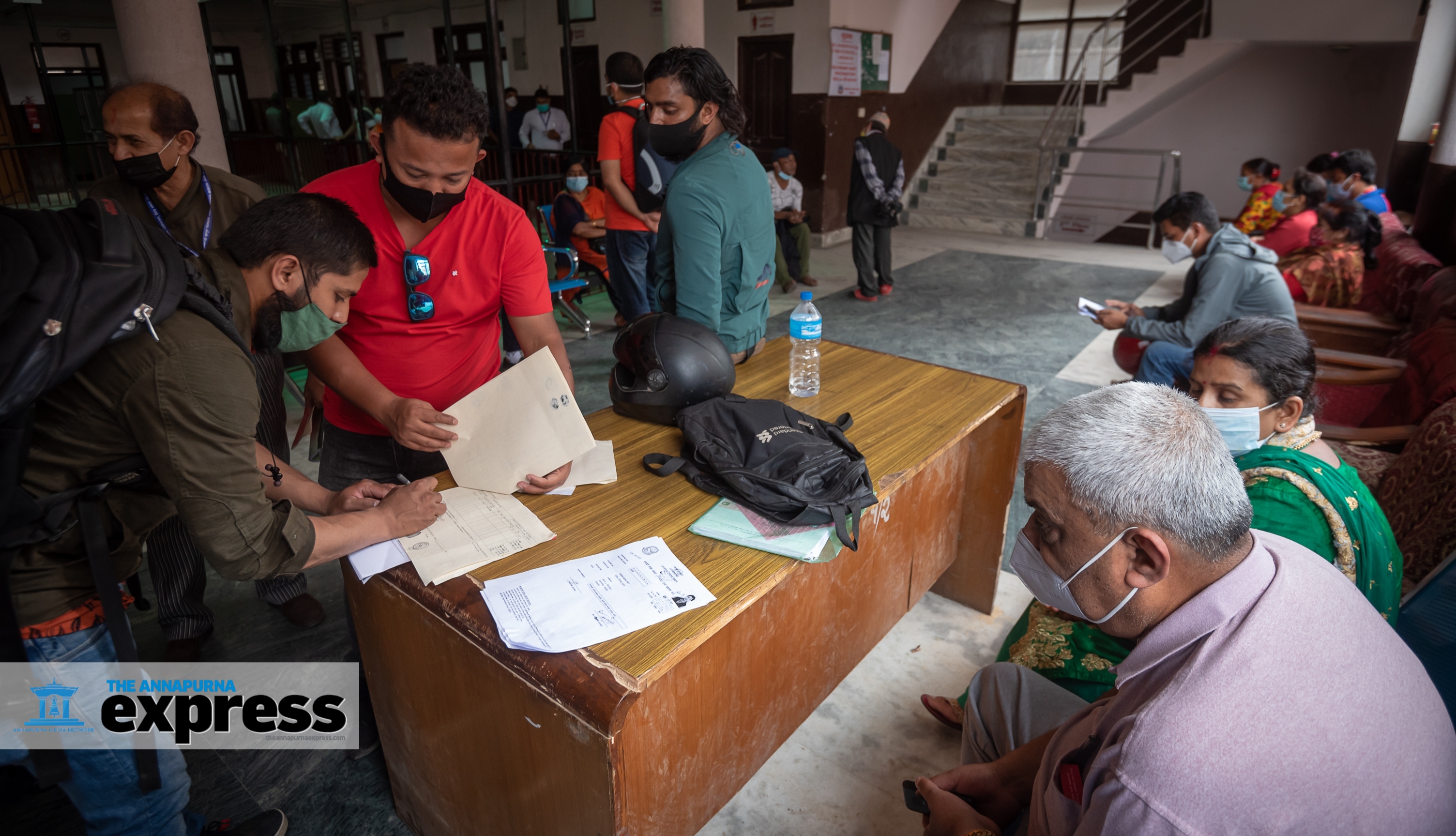Bhim Bahadur Thapa obituary: The man behind the perpetual search
Birth: 8 May 1920, Sindhuli
Death: 2 June 2022, Kathmandu
Bhim Bahadur Thapa, the man who left behind cryptic one-word message ‘Khoja’ in Devnagari script on streets, walls and electricity poles across the country, died on June 2 at the age of 104.
Thapa was a wizened old man of bent posture who wandered the streets and neighborhoods with a stick and a bag slung over his shoulders. He had this penchant of writing the word ‘Khoja’ (‘seek’) on whatever space he considered suitable with paint or chalk.
He was a man on a mission to make people seek knowledge and understanding human life.
Born to an ordinary family in Sindhuli district, Thapa never got formal education. He was an autodidact, who taught himself to read and write. At a young age, he became a passionate adherent of Karl Marx and his philosophy.
He believed in a casteless and classless society and joined the then Communist Party of Nepal in 1958. Thapa was an active participant in the communist movement of the time organized to protest against the monarchy.
During his years as a proponent of communism, he was detained on more than one occasion. But one day Thapa had a terrible epiphany: the communist parties of Nepal were faux-Marxists.
Disillusioned, Thapa left politics for good and in 1978 started his ‘Khoja’ campaign.
“Searching is an abstract thing, but it has made this world. Every other thing you see on earth is an outcome of searching, hence keep the spirit of search alive until you get your needs fulfilled,” Thapa once said.
One singular word ‘Khoja’ had a profound political, spiritual and philosophical meaning for those who meditated on it. This was what Thapa wanted: to get the attention of people with this simple word, make them pause for a moment–and think.
Thapa had fashioned his own flag for the campaign, with the word ‘Khoja’ with a cross of a pick-axe and hoe—in what was a clear indication of Marx’s influence on him.
To those who asked him about his work, he used to say that it was aimed against the feudal lords who exploited the masses. His goal was to organize his campaign around a group of adherents–just like Rup Chandra Bista did via his ‘Thaha’ movement in the 1970s.
Many people supported Thapa’s campaign, which lasted for a tad over four decades. But it never grew into a collective movement.
Thapa was against superficiality and insincerity. He wanted people to reflect, think, and most importantly, seek the truth.
That seeker of truth is now no more. Thapa is survived by three sons and seven daughters.
Parsing the election results
Nepali Congress, the leader of the five-party ruling coalition, seems to be in a mood for early elections. That should also suit CPN-UML, the main opposition, just fine. Although UML lost 89 top local level seats compared to its tally after the 2017 elections, the party in fact made a gain of 3.66m votes in all contested seats. Nepali Congress, for its part, got around 850,000 fewer votes than the UML. Had the five parties not ‘ganged up’ against it, UML could have trounced any individually contesting party, the party top-brass believes.
It is also hoping to prise away Maoist Center and Unified Socialist, the two communist coalition partners, from Nepali Congress before the upcoming federal and provincial elections. Upendra Yadav’s Janata Samajbadi Party might also be game for a rupture with Congress. Many top leaders of these three parties feel the Congress ‘betrayed’ them in local polls: even in joint tickets, while Congress won the top seats, they didn’t win the deputy seats as Congressis didn’t vote for them.
For the next few weeks the parties will be busy breaking down the results of local elections to chart a way forward. Sher Bahadur Deuba will have his work cut out keeping the coalition intact.
Full story here.
Travelogue: Traversing the Kathmandu-Tarai fast-track
I and Pratik Rayamajhi, our photojournalist, were assigned to cover progress on the much-talked Kathmandu-Nijgadh expressway. After quick planning and some basic research, I drew a route map with important landmarks. We would be roughly traveling via the Tinkune-Khokana-Hetauda-Makwanpurgadhi-Hetauda-Nijgadh-Kathmandu route.
We had planned on taking on a motorcycle but had to switch to a Mazda 4×4, which turned out to be a wise move: we would otherwise have had to return from halfway. (A piece of advice: If you’re traveling off-road on assignments, better take a four-wheeler, which is more comfortable, less tiring and easily accommodates luggage, allowing you to concentrate on your work.)
“A part of the expressway lies near my village in Makawanpur district,” our driver Som Moktan replied when I asked him if he had traveled via the proposed route. This was a huge relief, as we had no proper direction in mind. We had to travel on main roads as well as multiple small tracks to reach the fast track sites. Without Moktan, our three-day trip could easily have dragged on to a week.
At 8 am on February 15, we started our journey from our office at Tinkune and headed to Khokana. Along with clicking on-site photos in Khokana and Bungmati, we spoke to locals too. They were cooperative and helped us locate the proposed track and shared some of their concerns.
Nagesh Dangol, an elderly in Khokana who ran a small shop in his own house, took us to the Sikali Temple, which the Nepal Army had previously planned on razing to make way for the fast track. The plan was withdrawn following protests. Bungmati and Khokana are home to Hindu and Buddhist socio-cultural values and local arts and crafts industry, Dangol said. This heritage is sustained by the locals who still practice and celebrate ancient rituals and festivals. The expressway’s construction through these areas would destroy several heritage sites and ancient settlements—and with them, Dangol added, a whole civilization.

In 1996, King Birendra had proposed Khokana as a UNESCO World Heritage Site. In the proposal, Khokana was described as a unique village, a model of a medieval settlement pattern with a system of drainage and chowks. The local mustard-oil seed industry was called the ‘living heritage’ of the village.
We knew that many high-profile people were buying land in Khokana and Bungmati and pushing up their value with the help of realtors. Some Khokana residents also accused the activists and leaders who were campaigning against the fast track, for allegedly succumbing to greed and selling their lands. “Nepal Man Dangol, one of the leaders of a struggle committee against the fast track, has double standards. He sold his plot to the army and bought off properties close to the project site,” said a local woman who declined to give us her name.
After spending almost three hours at Khokana, we had a refreshing lunch at a local hotel. Next stop: Hetauda.
We took the Dakshinkali-Kulekhani route, a graveled road that nonetheless made for a comfortable trip. Moktan shared his driving experience and incidents throughout the way, preventing us from falling asleep.
We stopped at Kulekhani for a quick snack at 3 pm. There, we were in for a shock.
Even though we had planned our journey in a rush, a day earlier I had informed the spokesperson of Nepal Army Narayan Silwal that we were on a reporting assignment to cover the fast track. He had asked me to postpone our plan. I declined.
When we stopped at Kulekhani dam, army officials asked us why we had come to Kulekhani when we had planned on traversing the fast track route. It felt like the army had been tracking us. I started feeling a bit insecure from that point.
Yet I could still savor the majestic view of Kulekhani, along with sumptuous local fish.
 Kulekhani, Makwanpur.
Kulekhani, Makwanpur.
As we resumed our journey, I and Rayamajhi, the photographer, googled hotels in Hetauda. We surfed for a while but could not decide where to stay.
The first thing we did upon reaching Hetauda was look for hotels. It was already 7pm and we were tired. We picked a random hotel at Hetauda Chowk. Rayamajhi edited the photos and sent them to the office while I enjoyed the night-view from our balcony. After our 9pm dinner, we slept peacefully as we had to wake up early the next day to visit Makawanpurgadhi to study tunnel-work on the fast task.
Early at 6 am, Moktan woke us up, and we headed to Makawanpurgadhi. After traveling for two hours off-road, we reached the site and observed the tunnel work at Lendada. There, we interacted with workers, locals, and representatives at the ward office.
“Not only will the fast track improve our access to hospitals and schools, we will also be able to build more of them right here in our own village,” said Biru Tamang, a Lendanda villager. When I told him that the fast track would in fact not touch the village, directly or indirectly through auxiliary routes, he started getting a touch angry. He then accused ward officials for giving false hope to villagers.
According to the Nepal Army, for every Chinese worker employed on the fast track, there are three Nepalis employed. Chinese workers, moreover, are said to be imparting useful skills to their local counterparts. But the ground reality was different. “Although this mega project has come to our village, we are not getting the promised jobs,” says Dinesh Moktan of Bakaiya Rural Municipality in Makawanpur. “We asked the army for more local participation, but our plea was ignored.”
Throughout the journey, we also witnessed many violations of the Environmental Impact Assessment (EIA) report. Ram Bahadur Waiba, a resident of Bandarekholchha, was angry about indiscriminate felling of trees. The stumps of freshly cut trees were before our eyes, and Waiba, despite the language barrier, was demanding an explanation from a Chinese worker.
“They [Chinese workers] have chopped down almost a dozen trees for which they have no permit,” Waiba told us. There was an army camp nearby to listen to the concerns of those living in and around the project site. But Waiba said the army had ignored their complaints.
It was a clear case of the project contractor violating the EIA report. The army had already cut down the required number of trees in the area to make way for the fast track. Felling more trees went against the EIA mandate. The residents of Bandarekholchha told us that neither they nor the forest department was informed before more trees were axed.
Felled logs stacked at Budune, Makwanpur.
Our next stop was Budune, our driver Moktan’s village. We reached Budune at noon and had lunch before clicking photos of the track.
Moktan introduced us to his friends, who further outlined the locations and shared their concerns over the project. Locals of the Tamang settlement often felt uncomfortable when I approached, but as soon as Moktan explained our intent in his language, they would cooperate. Common language is a big connector, I felt.
As we were taking the photos of the hills, some local Nepal Army again officials started questioning us. They said we had no permit to take photos, as ‘the fast track belonged to the army’. We argued that the army team was obstructing the work of journalists. I was afraid that if I hesitated even for a bit with my answers, our cameras would be snatched and the photos deleted.
Our team was repeatedly accosted and questioned by the army in the course of reporting at fast track sites. They demanded a permit from army headquarters to take photos at some sites—all public places.
We then sent the photos to our office and headed to Nijgadh, our last destination.
It was already 10 pm when we reached Nijgadh. Again, in a hurry, we looked for a lodge, had our dinner, and exhausted, quickly hit the sack. Due to the covid restrictions, there was no chance of visiting the nearby market that was allowed to open only till 9.30 pm.
With no deadline pressure on the third day, we woke up at 8 am and proceeded to the fast-track entry point. Unfortunately, the army didn’t allow us into the area. We tried our best to convince them, but to no avail and had to return empty-handed.
But we were in Nijgadh and there was no way we would return without visiting the proposed area for the Nijgadh International Airport.
After a five-km ride via a graveled road amid the dense Nijgadh forest, we reached the dirt-poor Tangia Basti, a village with around 2,000 households. There was no electricity, no drinking water, and no proper transport. The local school taught students out on the open.
A team under former Prime Minister Madhav Kumar Nepal had visited the village a couple of days earlier. An elderly local, Harihar Gole, said the politicians were in favor of shifting the village in lieu of the airport that was to be built there. As such, the village had been kept in a limbo. After decades of promises, neither the airport nor development arrived.
We had our breakfast in the village and talked more to locals. They suggested we visit another nearby village—Kakadi—where the Army had planted trees in compensation for the ones that had been felled during the fast track construction.
We were now happy and relaxed as we would soon be returning home. But our relief didn’t last long. Near Kakadi, our Mazda got stuck, and we were unable to take it even after a couple of hours of relentless effort. Some local farmers pushed the vehicle, too, but again fruitlessly. They suggested we walk to the nearby village, which was two kilometers away, and hire a tractor to pull it out.
 Villagers helping to push our stuck Mazda.
Villagers helping to push our stuck Mazda.
I and Rayamajhi, hungry and tired, did accordingly. The ride back to the spot atop a tractor was a horrendous experience: it literally shook every part of our body. But our dying energy was soon revived when our Mazda was finally pulled out of the ditch. After thanking the villagers, we returned to the Mahendra highway and headed to Pathlaiya.
There we had a refreshing late lunch before rushing to Kathmandu.
Moktan took a shortcut, connecting to Lalitpur’s Chapagaun. After a whistle-stop tour, we had now finally arrived at our final destination: our Tinkune office. I handed over the car keys and came home for some much-needed rest.
Departure route:
Tinkune-Bungmati-Khokana-Dakshinkali-Kulekhani-Hetauda-Bakaiya-Makwanpurgadhi-Hetauda-Nijgadh
Arrival route:
Nijgadh-Tangia Basti-Kakadi-Nijgadh-Pathlaiya-Hetauda-Baguwa-Tinpane-Chapagaun-Tinkune
What if… the two-day weekend was made permanent?
Starting May 15, the government introduced a two-day weekend holiday, purportedly to reduce fuel consumption and stabilize the country’s foreign exchange reserves through less fuel imports. In these two weeks, there is no sign the decision has reduced public mobility or curtailed fuel consumption.
As fuel prices rocketed in the international market, they soared in Nepal as well. According to the Nepal Oil Corporation (NOC), the country currently consumes 150,000 kiloliters of diesel and 60,000 kiloliters of petrol a month, with a total burden of Rs 30bn on the exchequer. The state oil monopoly had projected, based on scant evidence, that the two-day public holiday would cut fuel consumption by 35 percent.
The NOC is already regretting its decision and the government is said to be mulling reinstating the six-day workweek.
Pushkar Karki, joint spokesperson of the oil monopoly, says there has been no meaningful reduction in average fuel consumption on Saturdays and Sundays. “If public mobility on these off-days remains as it is, we might as well roll back the two-day holiday provision,” he says.
The present two-day weekly off arrangement was spurred by economic necessities. But what if the situation were normal? Would the two-day weekend work in Nepal?
No, say the experts and officials ApEx talked to. In fact, they add, it will if anything adversely affect the economy of a developing country like Nepal.
Local governments, public institutions, schools, universities, and private sector bodies have already announced that they will not follow the government decision on the two-day weekly holiday. They say it would otherwise be difficult for them to sustain normal business.
They have a point. There are 52 Saturdays and as many Sundays in a year. Add to that 22 national holidays. This takes the total holiday count to 126 a year.
With that many public holidays, hardly anything will get done, says Chandra Mani Adhikari, an economist.
“There is no need for so many holidays. The two-day weekend decision has no scientific basis. If anything, it will make service-delivery worse,” he says.
In countries where the five weekdays provision is practiced, one extra day out of office is believed to give workers enough time to rest and recharge their batteries.
“Nepal, however, does not have the luxury enjoyed by those developed countries,” says Chakra Bahadur Khadka, an expert on petroleum products. “This is the time to work more and balance the economy. For that, we need to start using petroleum products on more productive ventures.”
This is not the first time Nepal has toyed with the idea of a two-day weekly off. It has already been experimented twice—in 1990 and in 1999.
The experiment was unsuccessful each time. Service-delivery was crippled as bureaucrats started leaving their offices early on Friday and coming late on Monday. “The public was soon up in arms against the new system,” remembers Kashiraj Dahal, an administrative affairs expert.

In 1990, the offices affiliated to the judiciary were the first to practice it, again to woeful consequences to service-delivery.
Then, again in 1991, the then Administration Reform Commission recommended a two-day weekend to reduce load-shedding and energy consumption.
The government of Prime Minister Krishna Prasad Bhattarai implemented the recommendation in Kathmandu valley fully eight years later, in 1999. Again, it was rescinded less than a year after its introduction.
The same tried and failed approach is yet again being implemented.
In 2020, the then Minister of Culture, Tourism, and Civil Aviation Yogesh Bhattarai had formed a committee to study if a two-day weekly holiday could increase internal tourism that was battered by the Covid-19 pandemic.
The report said that even if 10 percent of the almost 8m people who would get an extra day off went out on that day, local tourism would get a boost.
The committee had studied 127 countries, 116 of which practiced a five-day work week. Of the 43 countries in Asia under study, 38 had five weekdays. Among the SAARC member states, Nepal was the only country with a one-day weekend.
The 2020 research committee found that the international practice of two-day weekend helped workers relax and concentrate more at work. The report said that those countries had strictly implemented working hours on other days so that service-delivery wouldn’t be affected.
Before the committee’s findings could be put to use, the country was hit by another wave of Covid-19. The findings were then forgotten.
“We in Nepal cannot even ensure our civil servants are in office in the days and hours they should be. In this situation, implementing a two-day leave system will be filled with challenges,” adds Dahal, the administration affairs expert. He is thus unsure that a permanent five-day week is a viable option in Nepal.
It is noteworthy that every time the government has proposed or considered five working days, it has always come as an expedient to shore up a failing economy. Improving workers’ productivity or their mental health has never been the priority, unlike in more developed countries where the two-day weekend is in place.
Economist Dilli Raj Khanal also does not believe that the new provision will in any way reduce fuel consumption. “It would be better to look for other alternatives to increase forex, for instance by reducing petroleum consumption in government offices and projects.”
He also adds that longer weekly holidays will push back the deadlines of national projects, ultimately harming the national economy.
Unless the citizens are conscious of their behavior, Adhikari says, such arbitrary government rulings alone won’t mean much.
The two-day weekend plan will succeed, suggest administrative affairs experts, only if Nepal improves its work culture and packs the things done on Sundays in other working days.
Mahadev Panthi, spokesperson for the Office of Prime Minister, says the two-day weekly off decision is just in the second week of the trial phase, and it is difficult to speculate about its effectiveness this early into its implementation.
“We are in constant touch with the chief district officers and collecting feedback on the new system’s effectiveness. It’s an ongoing process,” he says.
Tulasi Prasad Paudel: Those into animal farming lack market-reach
According to the World Food Organization, a person needs 91 liters of milk, 48 eggs, and 14kg of meat a year. Former prime minister KP Oli had declared Nepal self-sufficient in meat and eggs on 25 March 2021, claiming that each Nepali was consuming 55 eggs and 22kg of meat annually. But Nepal’s poultry and fish farmers still have a long way to go when it comes to finding good markets and bringing out quality products. Pratik Ghimire of ApEx talked to Tulasi Prasad Paudel, a senior scientist specializing in animal research, who is also director at the government-run National Animal Science Research Institute (NASRI).
What are the institution’s core work areas?
We are involved in livestock farming and fishery. This institution monitors, coordinates, and regulates the capacity-building of farmers and other human resources. Similarly, we cooperate with governmental- and non-governmental organizations as well as educational institutions. Our institute also invents various technologies and distributes them to farmers and agricultural entrepreneurs with additional residential training opportunities.
What are you currently working on?
NASRI is developing new breeds of goats, cows, and buffaloes. For example, crosses of wild buffalo and domestic buffalo have been found to produce robust breeds. We conduct similar research on other animals.
Animal food determines the quality and quantity of milk so we’re developing affordable alternatives to ordinary feeds. Timing of feeding and heat stress also affects milk-production. We are conducting a series of experiments to help animals and farmers on this front as well.
We are developing animal medicine and vaccines. The severity of animal diseases varies on parameters like temperature, altitude, topography, food type, etc. and hence we can't rely on imported medicines.

Is there enough funding for your research?
Developed countries allocate over five percent of their total annual budget to agricultural and livestock research; the minimum global requirement is three percent of total budget. Developing countries generally allocate one to two percent of their annual budget. But in the past three decades, the Nepal government has spared a paltry 0.2-0.3 percent, or just six percent of the minimum recommendation.
What is the scope of animal farming in Nepal?
Good, I must say. We are still dependent on imported milk and dairy products. The Nepali market is filled with international brands of milk powder, cheese, and butter. We are independent in chicken meat and eggs yet there are other types of meats and fish we can work on.
Despite having a good scope, we lack market reach. If the government could increase the access of our local products to the core markets, our situation will drastically improve.
What do you suggest to the individuals who want to get into professional farming?
The farms that are doing profitable business all did good homework before starting out as. They consulted experts, took training, and relied on scientific research. I suggest the same for aspiring farmers and agricultural entrepreneurs.
Financial data hints of an economy in crisis
By all indications, Nepali economy is inching towards a crisis. The Nepal Rastra Bank (NRB) recently published the country’s current macroeconomic and financial status based on the first nine months’ data for the fiscal 2021/22. It says consumer inflation in this time inched up to 7.28 percent, imports increased by 32 percent while exports got a 69.4 percent boost (from a much lower base).
Similarly, remittances dropped by 0.6 percent, balance of payments remained at a deficit of Rs 268.26bn, and gross foreign exchange reserves stood at $9.61bn. The federal government spending amounted to Rs 794.26bn and the revenue collection stood at Rs 789.26bn. Here are the details:
Inflation
-
Consumer price inflation stood at 7.28 percent in March/April compared to 3.10 percent the same time a year ago. Food and beverage inflation was at 7.40 percent, whereas non-food and service inflation was 7.18 percent in the review months. Average inflation was 5.62 percent.
-
Under the food and beverage category, the prices of ghee and oil, milk products and eggs, pulses and legumes, and tobacco products subcategories rose by 28.36 percent, 11.56 percent, 10.53 and 8.91 percent respectively in a year-on-year basis. Likewise, under the non-food and services category, the prices of transport, education, and miscellaneous goods and services sub-categories rose by 20.16 percent, 8.79 percent and 8.17 percent respectively.
Foreign trade
-
Intermediate and final consumption goods accounted for 47.2 percent and 52.7 percent of the total exports respectively, whereas the ratio of capital goods in total exports remained negligible in the review period. At the same period of the previous year, the ratio of intermediate, capital and final consumption goods stood at 31.8 percent, 0.5 percent and 67.7 percent of total exports respectively.
-
On the import side, the share of intermediate goods stood at 53.2 percent, capital goods at 10.5 percent and final consumption goods at 36.3 percent in the review period. The respective ratios were 53.4 percent, 11.7 percent and 34.8 percent in the same period the previous year.
-
The unit value export price index increased 9.9 percent and the import price index increased 17.6 percent. The terms of trade index decreased 6.5 percent in the review months compared to a decrease of 3.2 percent a year ago.
-
Remittance inflows decreased 0.6 percent to Rs 724.74bn in the review period against an increase of 16.5 percent in the same period of the previous year.
-
Net transfer decreased 0.7 percent to Rs 808.92bn in the review period. Such a transfer had increased 14.4 percent in the same period of the previous year.

Foreign exchange reserves
-
Gross foreign exchange reserves decreased 16.5 percent to Rs 1.16trn in mid-April 2022 from Rs 1.39trn in mid-July 2021.
-
Of the total foreign exchange reserves, reserves held by the NRB decreased 17.9 percent to Rs 1.02trn in mid-April 2022 from Rs 1.24trn in mid-July 2021. Reserves held by banks and financial institutions (except NRB) decreased 5.1 percent to Rs 146.48bn in mid-April 2022 from Rs 154.39bn in mid-July 2021. The share of Indian currency in total reserves stood at 24.3 percent in mid-April 2022.
Expenditure and revenue
-
The total expenditure of the federal government stood at Rs 794.26bn. The recurrent expenditure, capital expenditure, and financial expenditure amounted to Rs 625.5bn, Rs 103.79bn and Rs 64.97bn respectively in the review period.
-
In the review period, revenue mobilization (including the amount to be transferred to provincial and local governments) stood at Rs 789.26bn. The tax revenue and non-tax revenue amounted to Rs 727.79bn and Rs 61.47bn respectively.
-
The federal government mobilized Rs 105.47bn domestic debt including Rs 50bn treasury bills, Rs 54.5bn development bonds and Rs 0.97bn citizen saving certificates.
-
Balance in various government accounts maintained with the NRB was Rs 333.08bn (including provincial government and local authorities account) in mid-April 2022 compared to Rs 200.18bn in mid-July 2021.
Deposit mobilization
-
Deposits at Banks and Financial Institutions (BFIs) increased 5.1 percent in the review period compared to an increase of 13.7 percent in the corresponding period of the previous year. Deposits at BFIs expanded 12.2 percent in mid-April 2022.
-
The share of demand, saving, and fixed deposits in total deposits stands at 8.7 percent, 28.7 percent, and 56.1 percent respectively in mid-April 2022. Such shares were 8.5 percent, 35.1 percent, and 48.2 percent respectively a year ago.
-
The share of institutional deposits in total deposits of BFIs stands at 38.6 percent in mid-April 2022. Such a share was 41.7 percent in mid-April 2021.
Refinance
-
The amount of refinance provided by the NRB stood at Rs 116.9bn in mid-April 2022.
-
As of mid-April 2022, the concessional loan is Rs 216.06bn extended to 145,693 borrowers. Of which, Rs 138.84bn has been extended to 59,931 borrowers for selected commercial agriculture and livestock businesses.
Interest rates
-
The weighted average 91-day treasury bills rate was 7.58 percent, which was 2.76 percent a year ago. The weighted average inter-bank transaction rate among commercial banks, which was 2.03 percent a year ago, increased to 6.99 percent in the review period. The weighted average interbank rate of BFIs, which is considered as the operating target of monetary policy, stood at 7 percent in the review period. Such a rate was 2.03 percent a year ago.
-
The average base rate of commercial banks stood at 9.17 percent, which was 6.90 percent a year ago. Weighted average deposit rate and lending rate of commercial banks stood at 7.11 percent and 10.78 percent respectively in the review period. Such rates were 4.79 percent and 8.61 percent respectively a year ago.
Capital Market
-
NEPSE index reached 2415.3 in mid-April 2022 compared to 2714.8 in mid-April 2021.
-
Stock market capitalization in mid-April 2022 stood at Rs 3.42trn compared to Rs 3.75trn in mid-April 2021.
-
The paid-up value of 6.68bn shares listed at NEPSE stood at Rs 658.33bn in mid-April 2022.
-
Securities worth Rs 182.76bn were listed at NEPSE. Such securities comprise government bonds worth Rs 54.5bn, debenture worth Rs 49.16bn, bonus shares worth Rs 47.96bn, ordinary share worth Rs 18.09bn, right share worth Rs 9.31bn, and mutual fund worth Rs 3.75bn.
-
The Securities Board of Nepal approved the total public issuance of securities worth Rs 15.05bn in the review period, which includes debenture worth Rs 4.8bn, ordinary share worth Rs 3.79bn, right share worth Rs 3.46bn and mutual fund worth Rs 3bn.
Source of all data: Nepal Rastra Bank
Based on nine months’ data ending mid-April 2021/22
Vox Pop | First-time voters weigh their options
A total of 137,043 people have filed their candidacies for 35,221 posts in the May 13 local elections: 3,276 for mayor, 2,009 for deputy mayor, 3,264 for chairperson, 2,296 for vice-chairperson, and 32,217 for ward chairperson. Similarly, 23,521 candidacies have been filed for women members, 21,221 for Dalit women members, and 49,239 for ward members. There are 17.7m voters—and 3.6m of them are new ones. There is a great deal of curiosity about the voting preferences of these first-time voters. Pratik Ghimire of ApEx interviewed 10 of them.
Jayanti Thakur, 19
Pipra Rural Municipality, Mahottari

I am under pressure, including from my family, to vote for the candidate of a certain political party. Telling someone to vote against their will is wrong. So I am going to use my right carefully. I will compare all the candidates and vote for the progressive ones. I am particularly focusing on women candidates because they are capable too. It’s just that they are not given the right opportunities by political parties. Women candidates make only 10.4 percent of total candidates this time. It is a shame that our political parties are still not willing to give women the right opportunity to lead.
Kusum Pariyar, 19
Dhulikhel Municipality, Kavre

I am disgusted by Nepal’s political situation. The local level at least should be free of politics because we need representatives who can serve their communities. But the reality is different. The candidates want the mayoral post for their political parties. I haven’t found one good political candidate. A couple of independent candidates look promising, but the chances of them winning are slim. Honestly, I am not very excited about this election.
Kartabya Regmi, 20
Changunarayan Municipality, Bhaktapur

In the 2017 local polls, I went to my municipality’s polling booth with my parents as I wanted to see what voting looks like. I have wanted to vote since that time. Reaching a voting age means that you are now a responsible citizen. So I am excited. Each position in the local government has its own working area, power, and limits that have been beautifully set by our constitution. If elected representatives work within those parameters, I guess our problems will be solved. I will vote based on the strengths of individual candidates, not based on their political affiliations.
Sarishma Kafle, 20
Nijgadh Municipality, Bara

Last month, I took a training session on ‘voter education’. It taught me the importance of voting, and helped me understand my responsibility for the country’s future. I have researched every candidate contesting local elections from my municipality. I want to experience the election atmosphere in my hometown, so I am back here from Kathmandu for the polls. This is an exciting time. Some of my distant relatives are also contesting. I had never talked to them before, but I recently got their calls and they were asking for my vote. It is strange that they want me to vote for them because I am their relative. They didn’t even try to convince me why I should pick them.
Siddhant Paudel, 20
Kushma Municipality, Parbat

I am excited and nervous at the same time. I am not going to vote for the old, outdated candidates because they have been tried and tested several times and each time they have failed to deliver. I am supporting young candidates. This election is an opportunity to change old ways. Youths should lead at the local level. At the back of my mind, I also think, what if we elect young representatives and they too disappoint in the end? It is such a strange feeling but I am happy that at least I am being a responsible citizen by exercising my franchise.
Aaditya Baniya, 21
Birgunj Metropolitan City, Parsa

The past five years were a waste of time. During the Covid-19 pandemic, Birgunj had become a coronavirus hotspot, but the work of the local government was dismal. It showed that we were being led by incompetent leaders. I am looking for alternative candidates who can work on smaller but effective agendas like drinking water, transport, waste management, and parking. The big agendas of political candidates are all lies. I will vote for a social reformer who has already worked in my area, even though he may not hold any political position. They care for the community. Candidates fielded by the political parties are with the people only during elections.
Rasil Adhikari, 21
Tarakeshwor Municipality, Kathmandu

After reaching the legal voting age, I started studying how democracy functions and the value of my vote. There are certain things I want from my candidates. While the majority of the people seem to be motivated by their political allegiance, I am looking at the vision and values that the candidates bring to the table. My single vote may very well get buried among thousands of others, but my wisdom counts as much as anything. I will vote for someone who stands out among the candidates.
Nilesh Niroula, 22
Barahakshetra Municipality, Sunsari

There is a generation gap between our leaders and young people. Times are changing fast and these leaders are not adapting. I want to see someone who is young and competent lead my municipality and my country. I am familiar with the politics of Nepal and I don’t see any candidate worthy of my vote. Where do I show my disapproval of candidates? Why are political parties afraid of the ‘none of the above’ (NOTA) ballot option? It is high time that old politicians gave up their posts so that young people can lead this country. I am looking for a leader who can inspire this country’s youths.
Prativa Regmi, 22
Jaljala Rural Municipality, Parbat

We are just days from casting our votes, but I haven’t been able to find a worthy candidate with a clear vision and agenda. The candidates in the fray don’t represent us. They are here to serve their political parties. I was looking for a candidate who could assure the public with sound health, education, transport, and employment ideas, but there is no one. So I have decided not to vote and save myself from being a reason for the failure of this country.
Sulochana Yadav, 22
Tirahut Rural Municipality, Saptari

I am eager to vote on May 13. I now have the responsibility of choosing the right leaders for my municipality and my country. I am also curious about the candidates, especially the young ones. I have been discussing the works and backgrounds of candidates with my friends to figure out who the right representatives may be. We are all excited about voting for the first time. I think I will this time vote for candidates with good professional backgrounds.
Ila Sharma: Vote, or stop complaining
Why vote? This is the question many people are asking on the eve of the May 13 local election. Pratik Ghimire of ApEx put the same question—plus a few more—to Ila Sharma, former commissioner at the Election Commission.
Why is local election important?
It is important to decentralize the centralized power. Without local elections, there won’t be any local governments, which will deprive us of government services at our doorsteps. It is also crucial for local development because the respective villages know what model of development is necessary in their areas, not Kathmandu.
Why should people vote in local elections?
By voting we elect our representatives so that they can govern us. If we don't vote, there will be no grounds to complain against the incompetence of the ruling representatives. So to send progressive candidates, who you think can bring about meaningful reforms in your area, you must vote.
What is the historical trajectory of voter turnout in Nepal?
Studies suggest that the voter turnout of developing countries is better than that of developed countries. We have a similar case here. We have a good voter turnout. People in developing countries are mostly fed up with the political situation and incompetence of their leaders. This encourages them to vote and try alternative leadership.
What reforms do you advocate in our electoral system?
There are a lot of things. We can write a book on it. But the important ones are curbing electoral expenses, guaranteeing inclusiveness, and adopting an electronic voting system.
Our constitution says that there should be at least one female candidate for the post of mayor/chairperson or deputy mayor/vice-chairperson. But it also says, this provision only applies if a single party fields candidates for both the posts—and it does not apply to a coalition of parties. This has significantly undercut the participation of female and other marginalized communities.
Likewise, if electronic voting were introduced, no vote would be wasted.
Also, there are issues of incorporating ‘none of the above’ (NOTA) voting option on ballot papers and ensuring voting for Nepali immigrants.
How would you compare Nepal’s grassroots democracy, say, with the same in the rest of South Asia?
On paper, we offer a lot of promise. But in practice, there are many things that need to be improved. Yet, compared to other South Asian countries, we are doing well as our grassroots democracy is more powerful than that of India or Bangladesh.















